The Effect of Coupling Solar Thermal System and Geothermal Heat Pump Systems in Areas with Unbalanced Heating and Cooling Demand
Abstract
:1. Introduction
2. Method
2.1. Overview of the Target Building
2.2. System Configurations
3. Results and Discussion
3.1. Operation Behaviors of GSHP with and without the Solar Thermal System
3.2. System Performance Analysis
3.2.1. Influence of the Supply Temperature on Heat Pump Performance
3.2.2. Power Consumption According to the Operation Mode
4. Conclusions
Author Contributions
Funding
Informed Consent Statement
Data Availability Statement
Conflicts of Interest
Abbreviations
| COP | Coefficient of Performance |
| SPF | Seasonal Performance Factor |
| E | Electricity consumption [kW] |
| TOA | Outdoor Air Temperature [°C] |
| RS | Solar Radiation [W/m2] |
| TS_H | Supply water Temperature for Heating |
| TR_H | Return water Temperature for Heating |
| FH | Water Flow rate for Heating [m3/h] |
| FHP_G | Water Flow rate for Heat Pump from Geothermal [m3/h] |
| FHP_S | Water Flow rate for Heat Pump from Solar collecting [m3/h] |
| TS_HP | Supply water Temperature for Heat Pump [°C] |
| TR_HP | Return water Temperature for Heat Pump [°C] |
| THT | Water Temperature of the High-Level Heat storage Tank [°C] |
| TLT | Water Temperature of the Low-Level Heat storage Tank [°C] |
| TS_S | Supply water Temperature for Solar collector [°C] |
| TR_S | Return water Temperature for Solar collector [°C] |
| FS | Water Flow rate for Solar collector [m3/h] |
References
- Joo, B.K. Geothermal heating and cooling systems, initial investment and operating costs are excessively higher than gas heating and cooling systems. Gas News. 2020. Available online: http://www.gasnews.com/news/articleView.html?idxno=91688 (accessed on 15 November 2020).
- Sanner, B.; Karytsas, C.; Mendrinos, D. Current status of ground source heat pumps and underground thermal energy storage in Europe. Geothermics 2003, 32, 579–588. [Google Scholar] [CrossRef]
- Hepbasli, A.; Akdemir, O.; Hancioglu, E. Experimental study of a closed loop vertical ground source heat pump system. Energy Convers. Manag. 2003, 44, 527–548. [Google Scholar] [CrossRef]
- Kang, E.C. Invigorating the Geothermal Market, “Communal Housing” will be responsible for vitalizing the geothermal marker. Korea Heating Air-Conditioning & Renewable News. 1 October 2015. Available online: http://www.kharn.kr/news/article.html?no=392 (accessed on 15 November 2020).
- Shahed, A.M.; Harrison, S.J. Preliminary review of geothermal solar assisted heat pumps. In Proceedings of the 4th Annual Canadian Solar Buildings Conference, Toronto, ON, Canada, 25–27 June 2009. [Google Scholar]
- Lohani, S.P.; Schmidt, D. Comparison of energy and exergy analysis of fossil plant, ground and air source heat pump building heating system. Renew. Energy 2010, 35, 1275–1282. [Google Scholar] [CrossRef]
- Yu, T.; Liu, Z.; Chu, G. Influence of intermittent operation on soil temperature and energy storage duration of ground-source heat pump system for residential building. In Proceedings of the 8th International Symposium on Heating, Ventilation and Air Conditioning—Volume 2: HVAC&R Component and Energy System; Li, A., Zhu, Y., Li, Y., Eds.; Springer: Berlin/Heidelberg, Germany, 2014; pp. 203–213. [Google Scholar]
- Qian, H.; Wang, Y. Modeling the interactions between the performance of ground source heat pumps and soil temperature variations. Energy Sustain. Dev. 2014, 23, 115–121. [Google Scholar] [CrossRef]
- Retkowski, W.; Ziefle, G.; Thöming, J. Evaluation of different heat extraction strategies for shallow vertical ground-source heat pump systems. Appl. Energy 2015, 149, 259–271. [Google Scholar] [CrossRef]
- Liu, Z.; Xu, W.; Qian, C. Investigation on the feasibility and performance of ground source heat pump (GSHP) in three cities in cold climate zone, China. Renew. Energy 2015, 84, 89–96. [Google Scholar] [CrossRef]
- You, T.; Wu, W.; Wang, B.; Shi, W.; Li, X. Dynamic soil temperature of ground-coupled heat pump system in cold region. In Proceedings of the 8th International Symposium on Heating, Ventilation and Air Conditioning—Volume 2: HVAC&R Component and Energy System; Li, A., Zhu, Y., Li, Y., Eds.; Springer: Berlin/Heidelberg, Germany, 2014; pp. 439–448. [Google Scholar]
- Dai, L.; Li, S.; DuanMu, L. Experimental performance analysis of a solar assisted ground source heat pump system under different heating operation modes. Appl. Eng. 2015, 75, 325–333. [Google Scholar] [CrossRef]
- Shang, Y.; Dong, M.; Li, S. Intermittent experimental study of a vertical ground source heat pump system. Appl. Energy 2014, 136, 628–635. [Google Scholar] [CrossRef]
- Tian, Y.; Wei, W.; Wenxing, S.; Baolong, W.; Xianting, L. An overview of the problems and solutions of soil thermal imbalance of ground-coupled heat pumps in cold regions. Appl. Energy 2016, 177, 515–536. [Google Scholar]
- Ni, L.; Song, W.; Zeng, F.; Yao, Y. Energy saving and economic analyses of design heating load ratio of ground source heat pump with gas boiler as auxiliary heat source. In Proceedings of the 2011 International Conference on Electric Technology and Civil Engineering (ICETCE), Lushan, China, 22–24 April 2011; pp. 1197–1200. [Google Scholar]
- Chen, X.; Yang, H.X.; Lu, L. Experimental studies on a ground coupled heat pump with solar thermal collectors for space heating. Energy 2011, 36, 5292–5300. [Google Scholar]
- Korean Agency for Technology and Standards. Solar Thermal Collectors, KS B 8295. 2015; pp. 30–36. Available online: https://standard.go.kr/KSCI/standardIntro/getStandardSearchView.do?menuId=919&topMenuId=502&upperMenuId=503&ksNo=KSB8295&tmprKsNo=KSB8295&re (accessed on 15 November 2020).
- Khaled, Z.; Amenallah, G.; Ramzi, S.; Chakib, K. Solar thermal systems performances versus flat plate solar collectors connected in series. Engineering 2012, 4, 881–893. [Google Scholar]
- Hong, P.J.; Seoung, L.W.; Kim, Y.K. The cooling seasonal performance factor of a hybrid ground-source heat pump with parallel and serial configurations. Appl. Energy 2013, 102, 877–884. [Google Scholar]
- Lim, H.J. Performance evaluation and economic estimation of ground source heat pump cooling and heating system. J. Energy Eng. 2004, 13, 296–300. [Google Scholar]
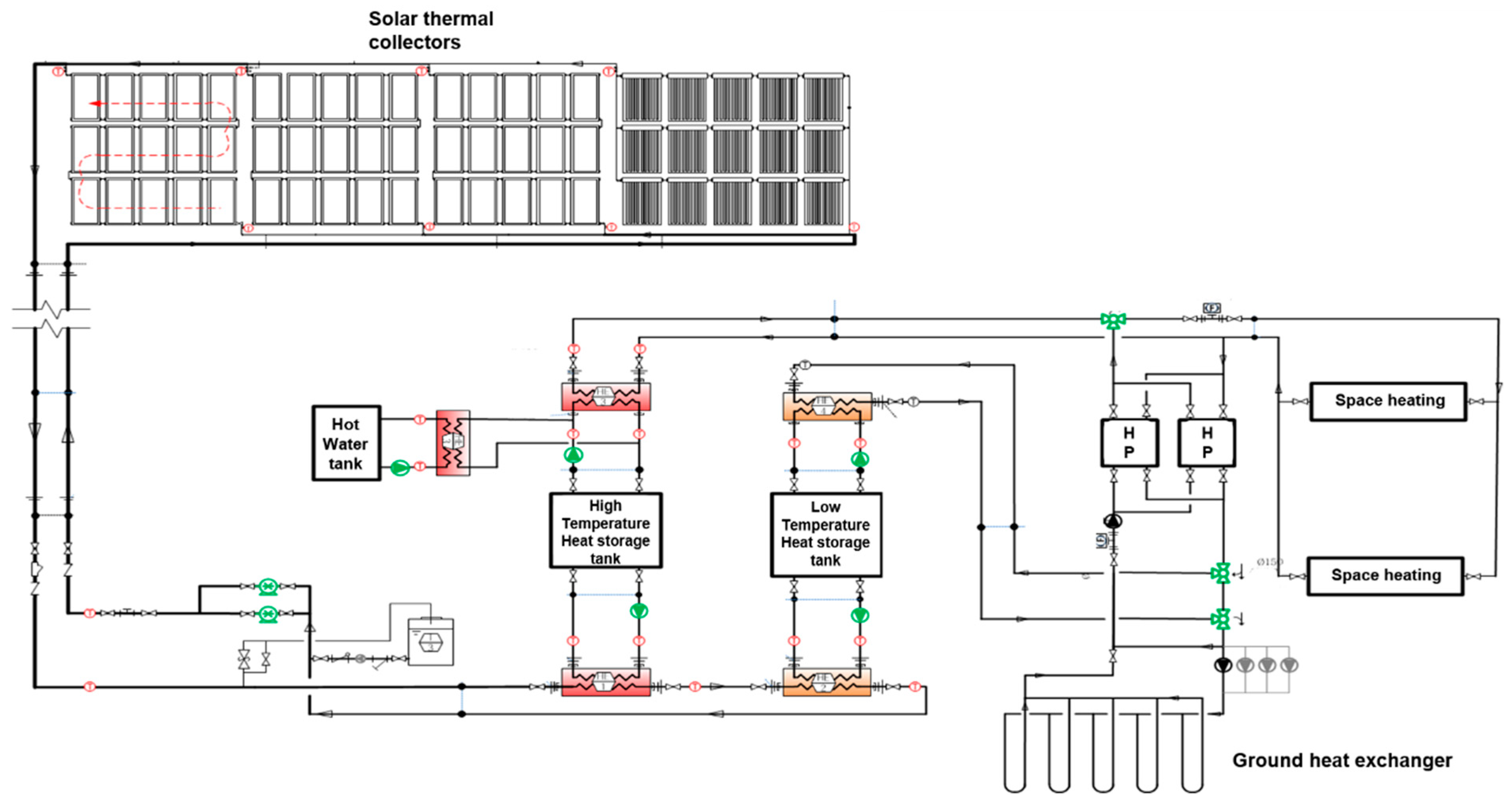

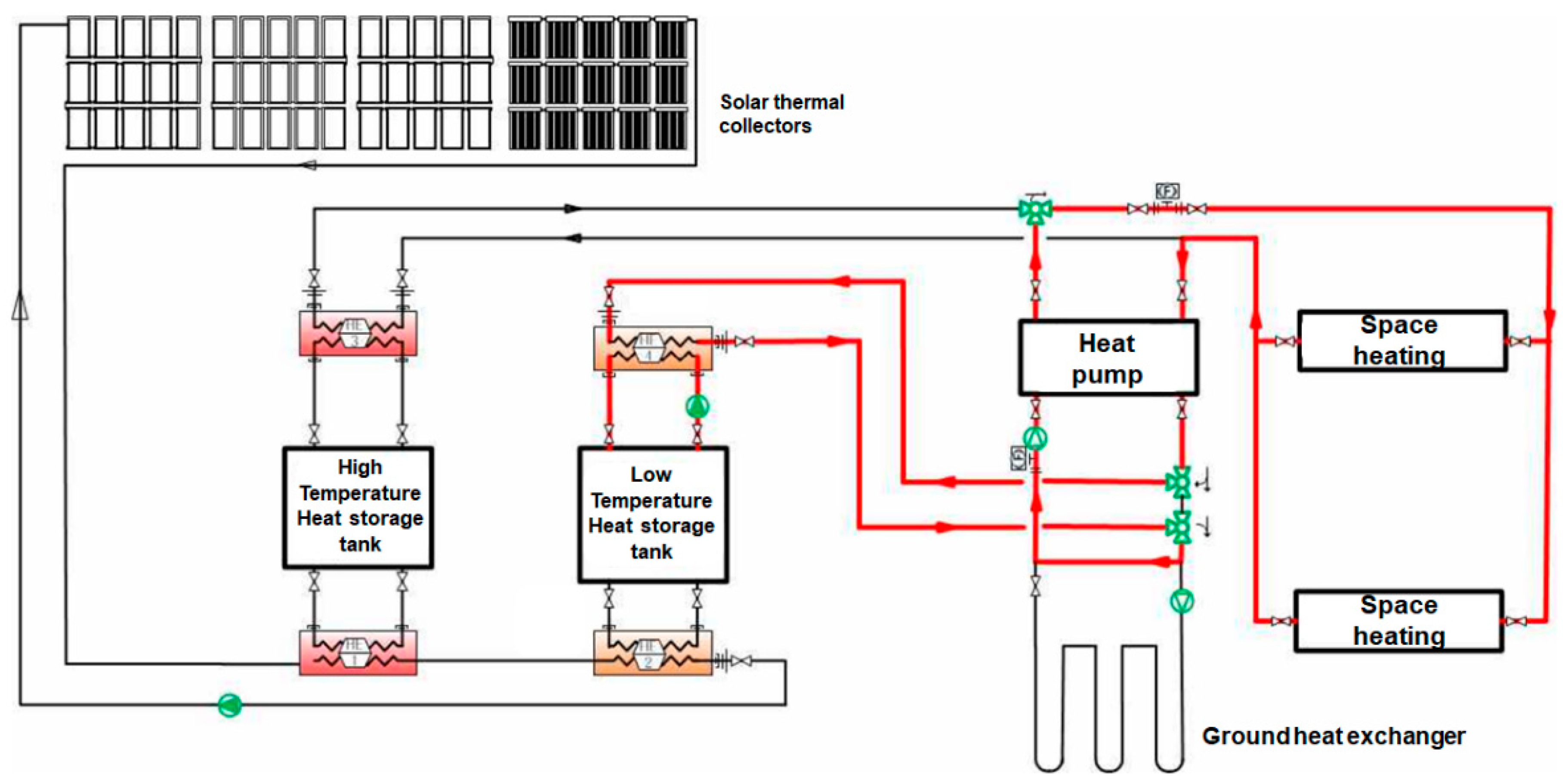
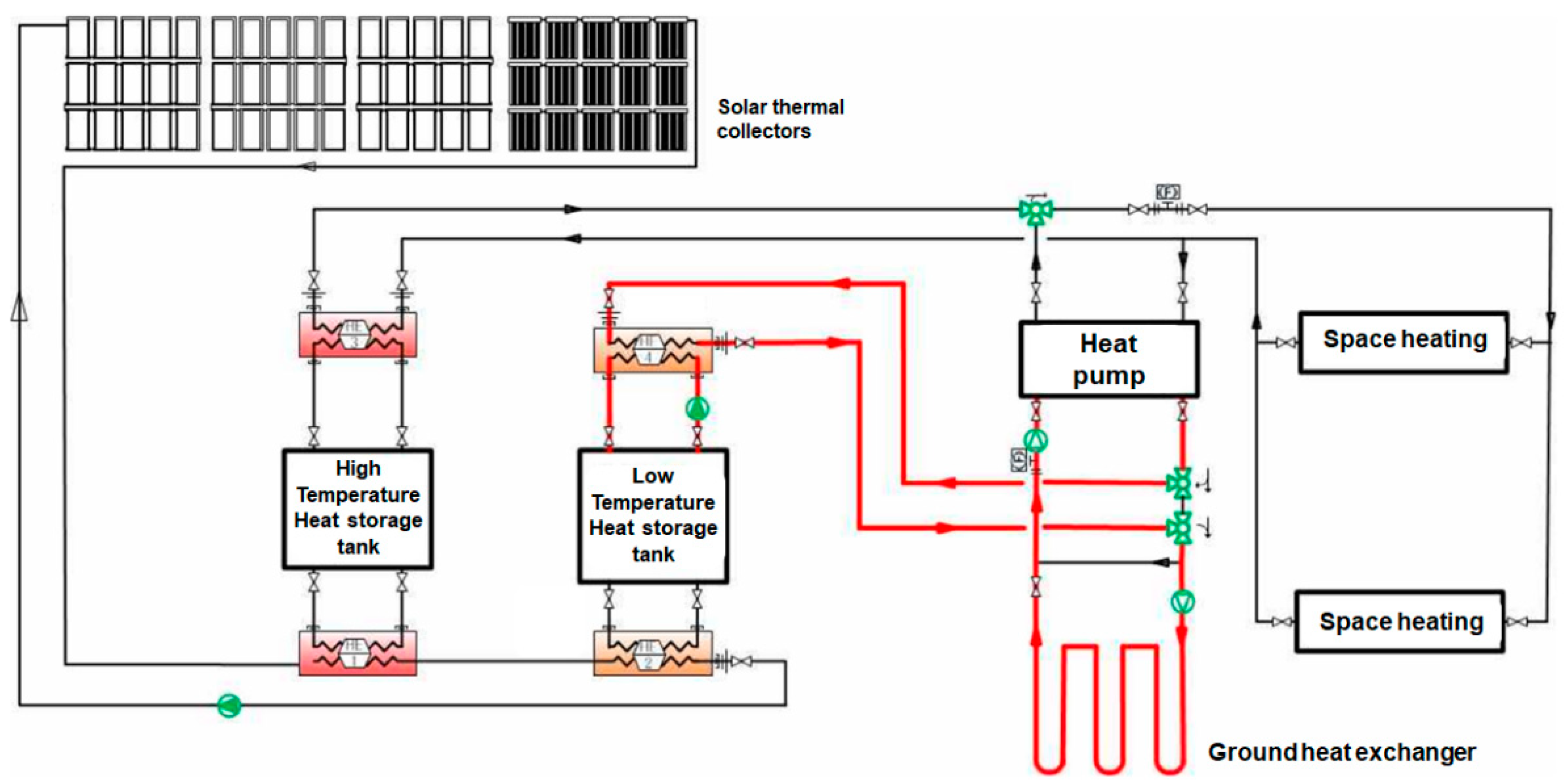
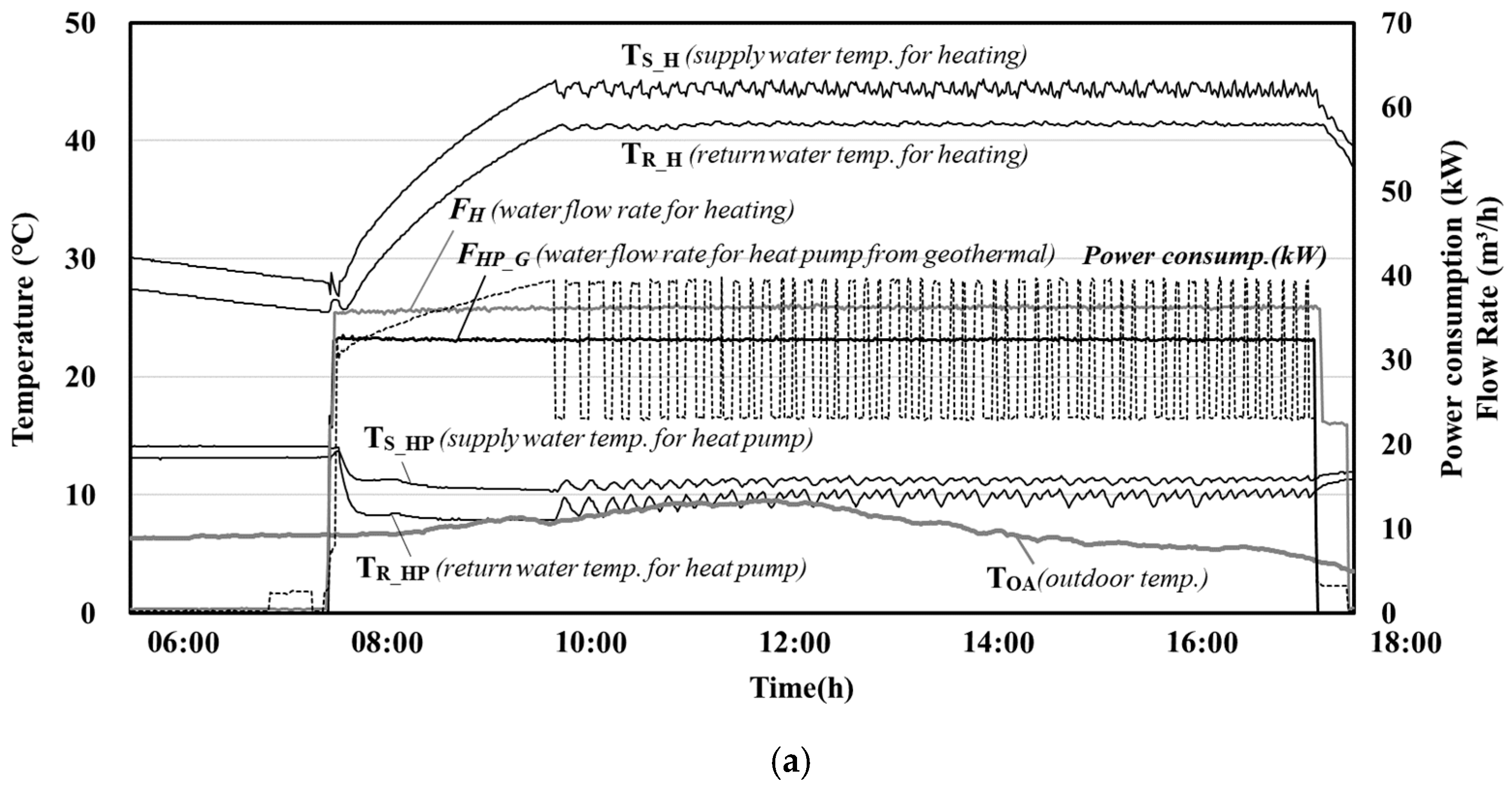
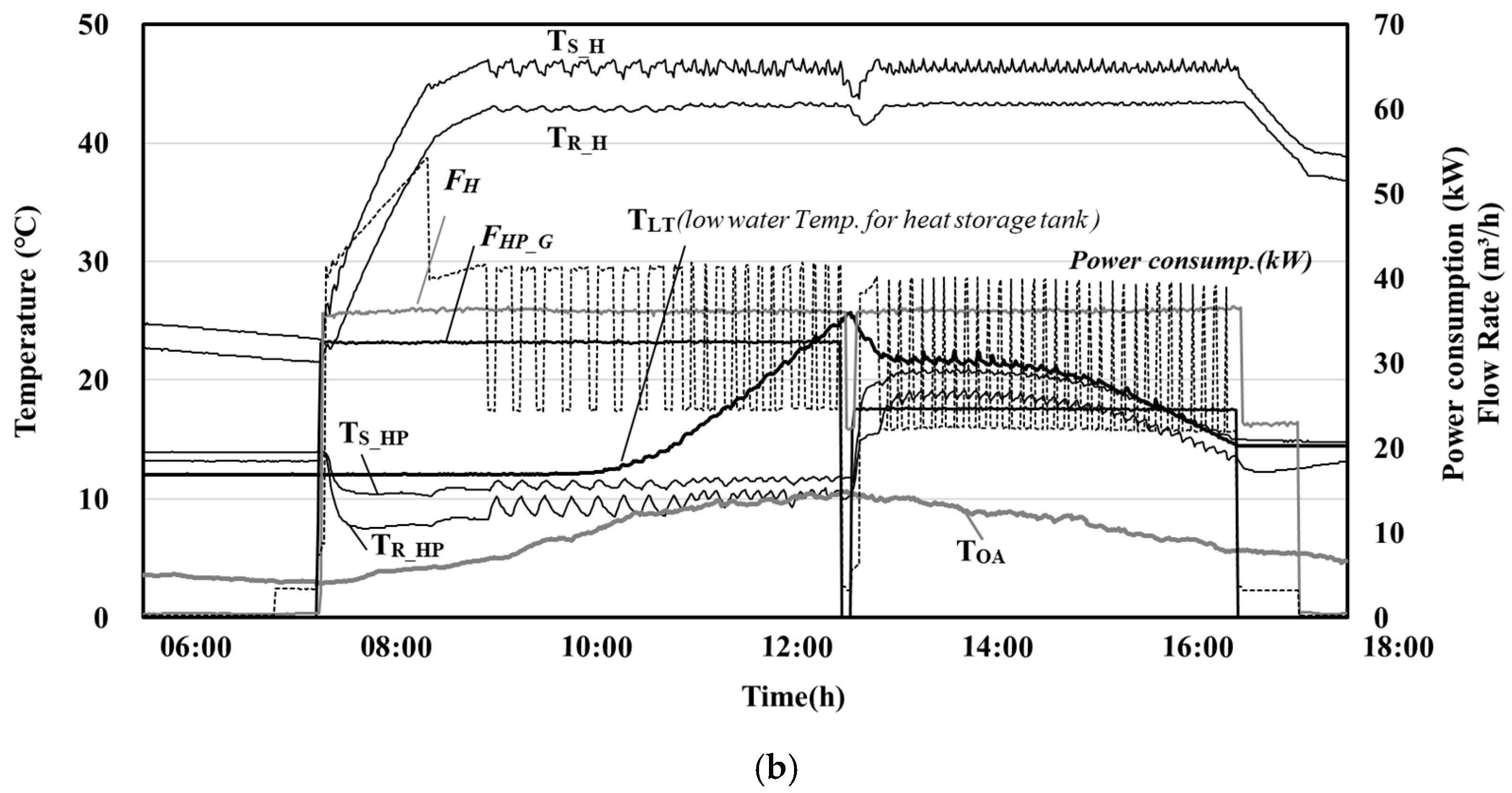
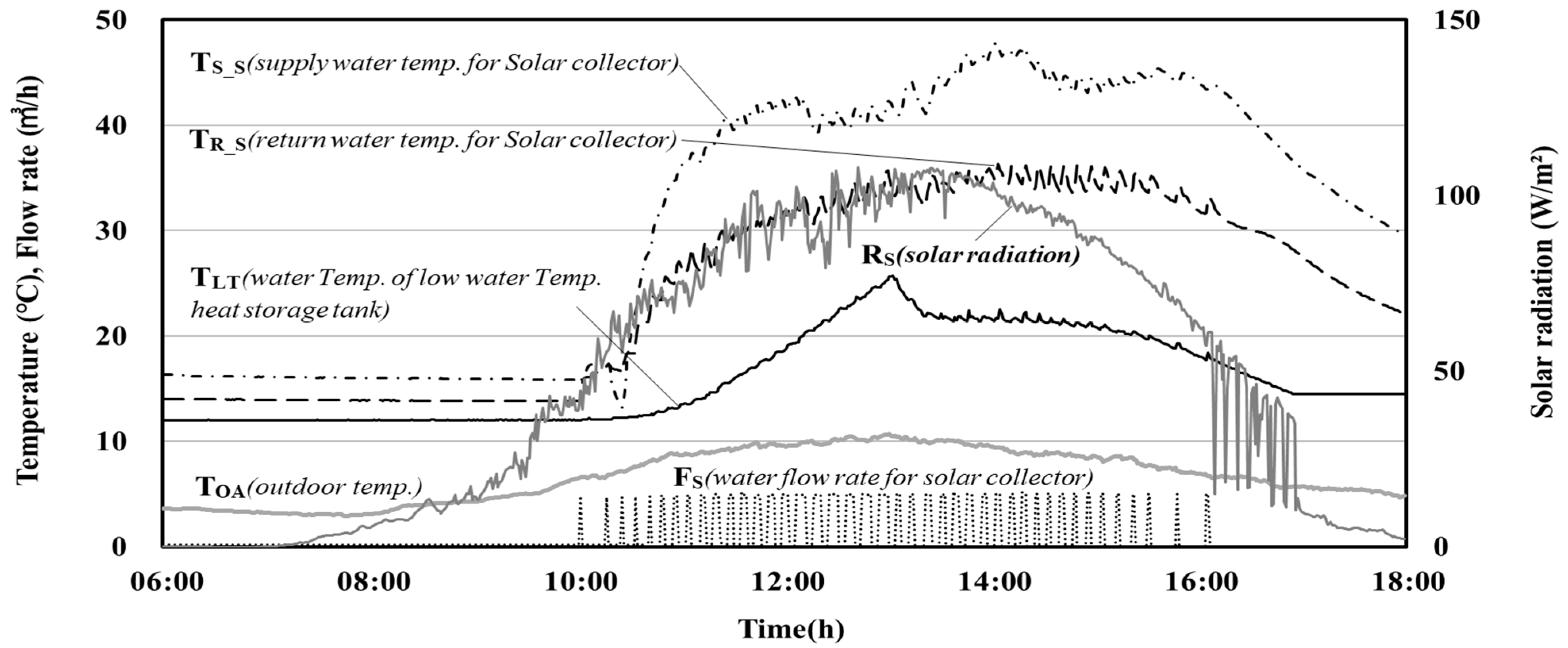
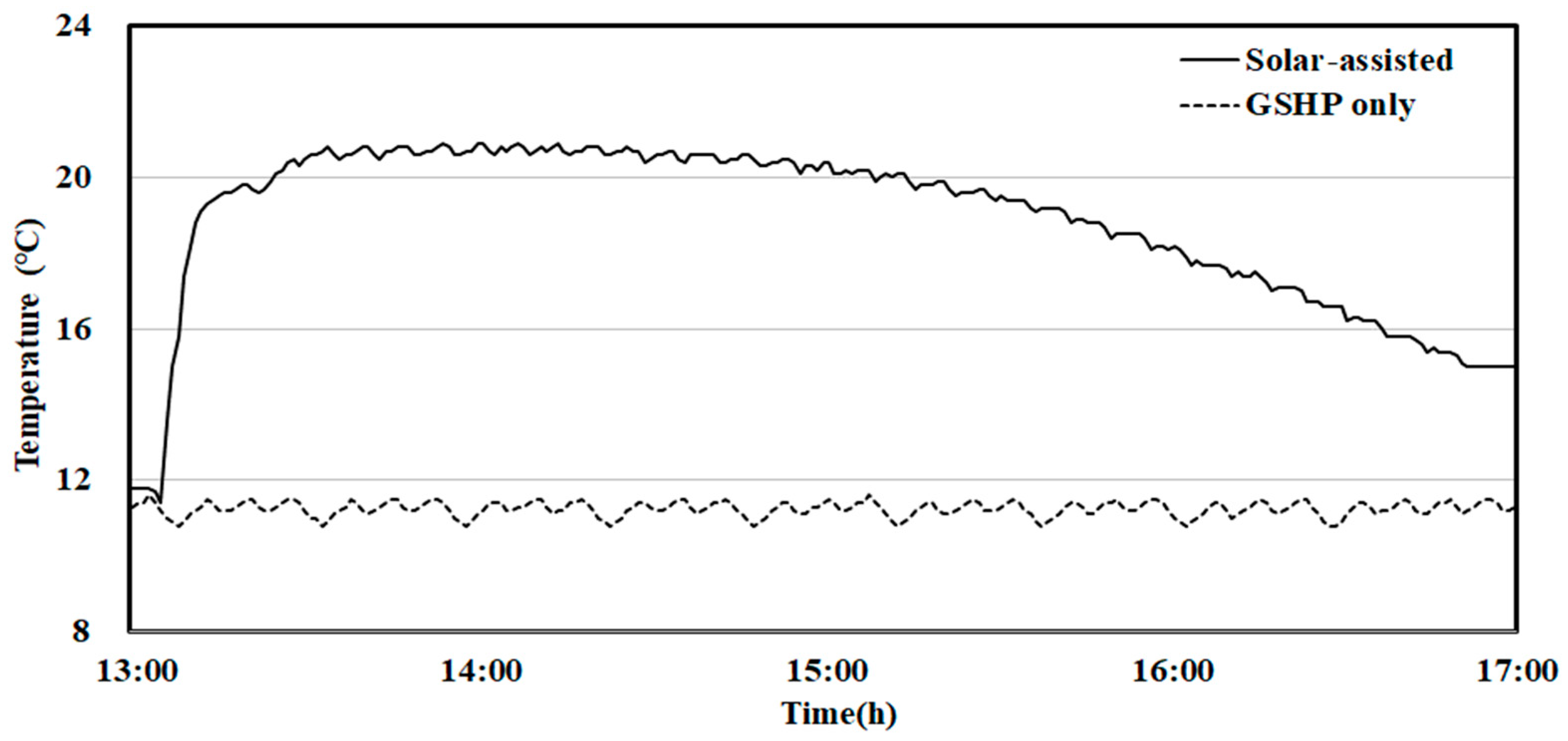
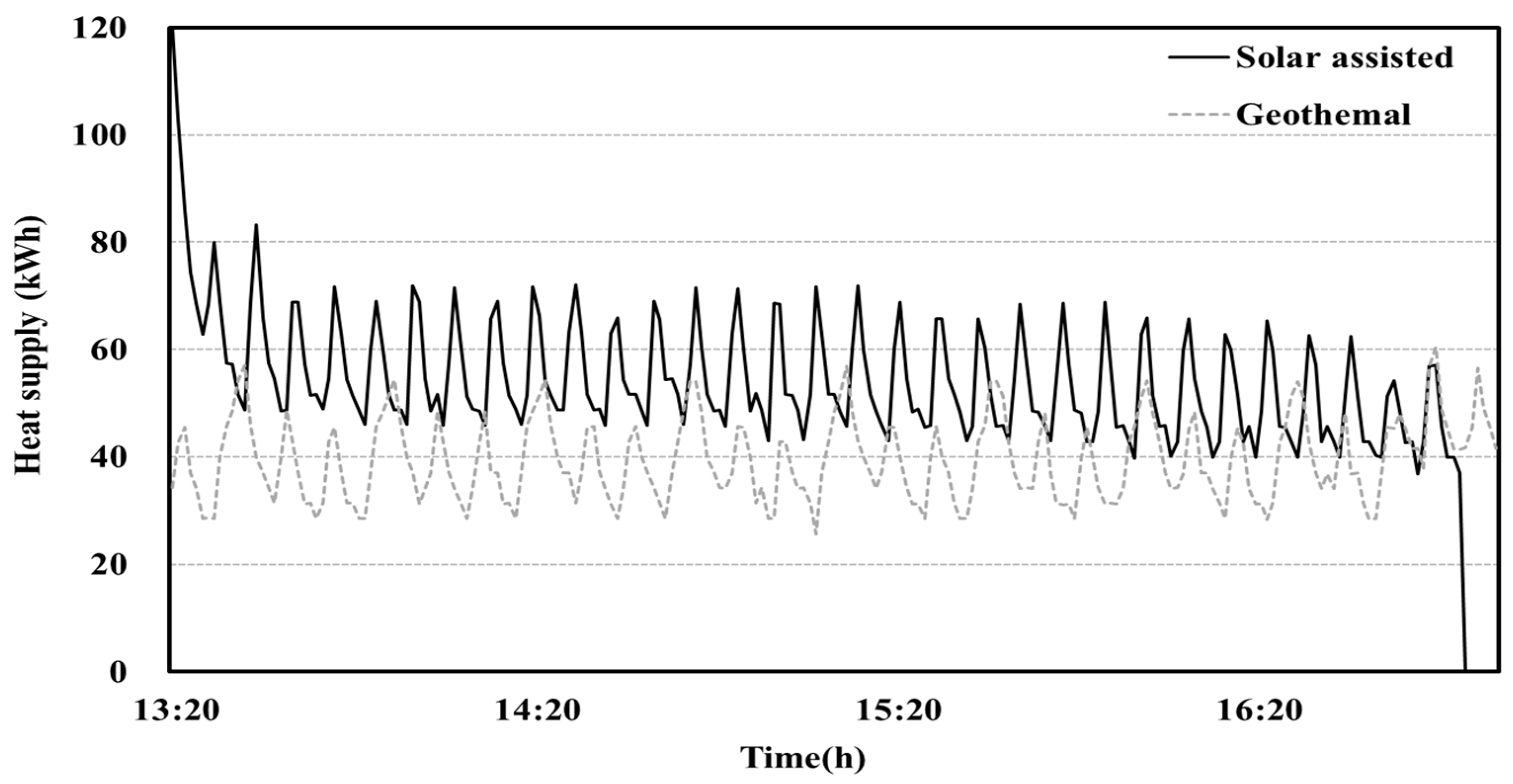
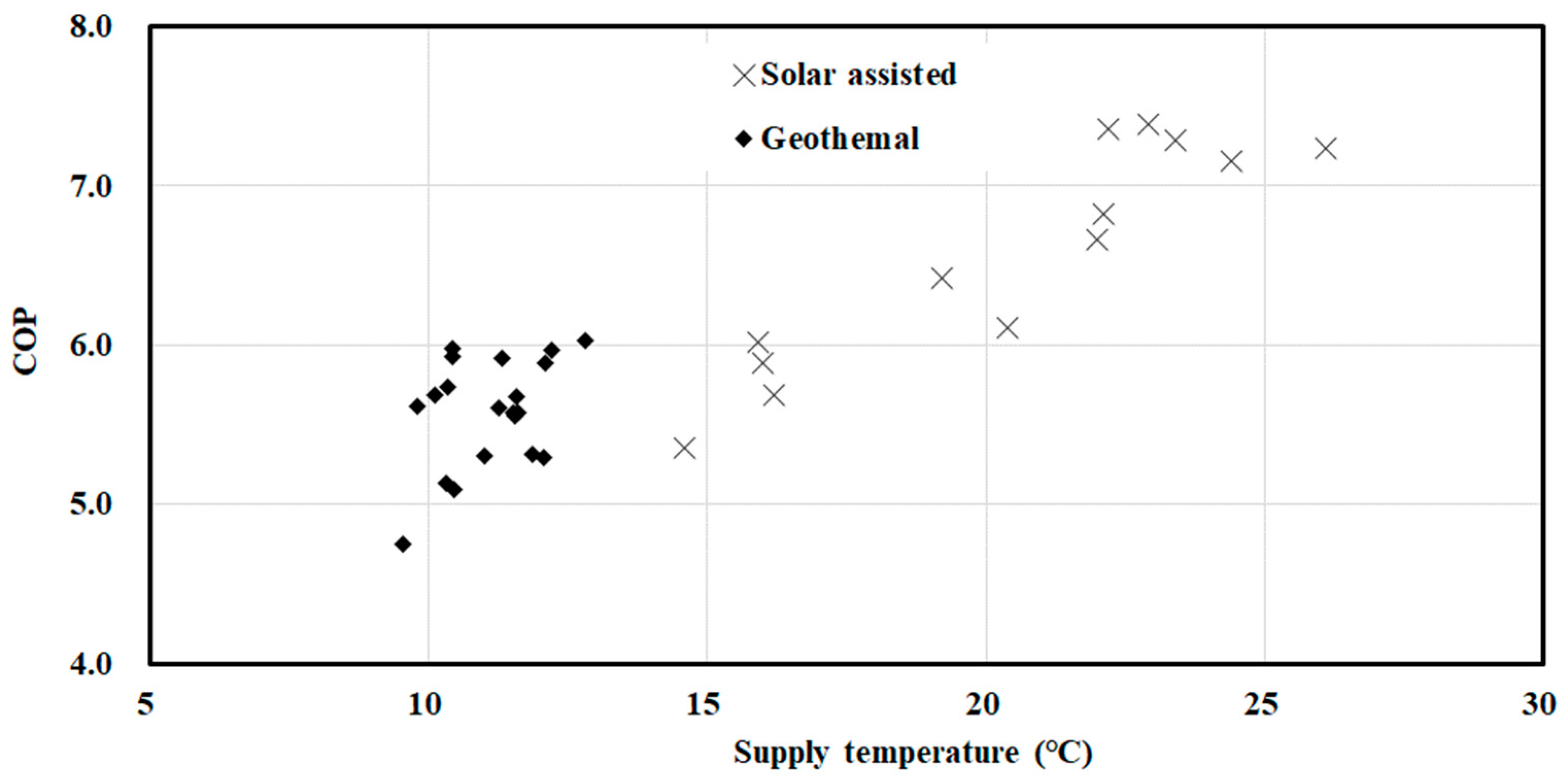
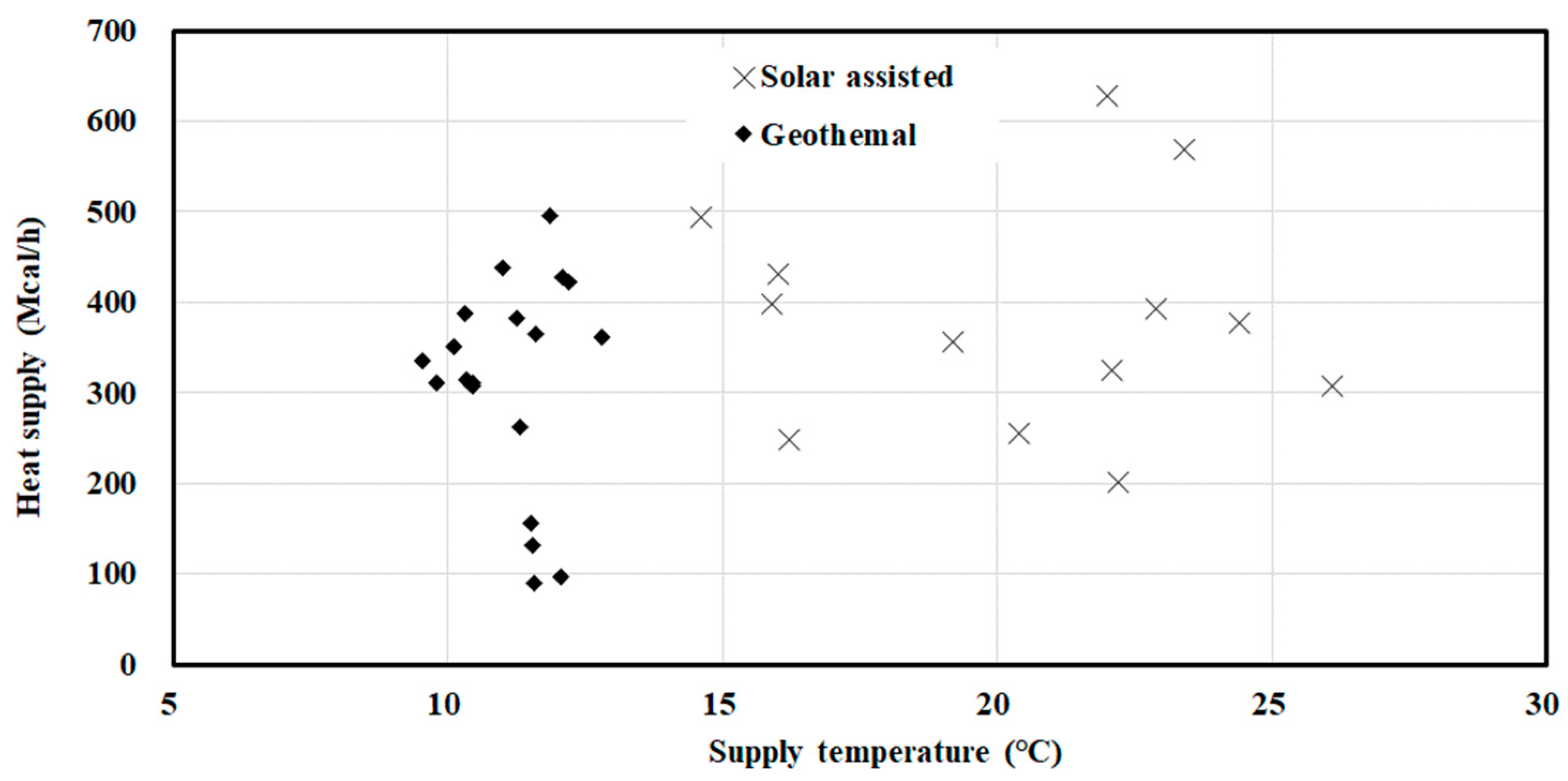
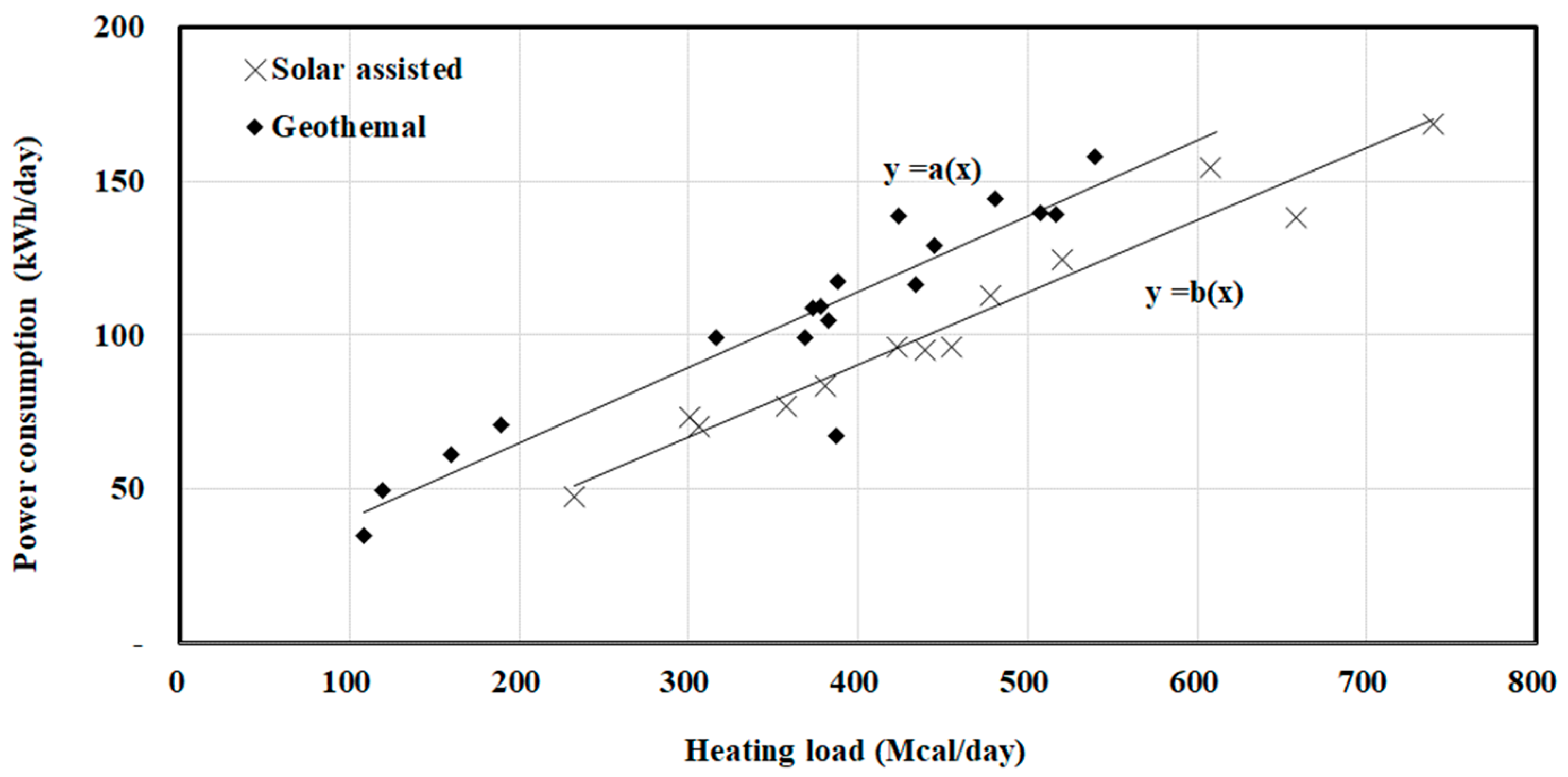

| Zone | Area (m2) | Cooling Load (kWh) | Heating Load (kWh) | Operation Time (h) | ||
|---|---|---|---|---|---|---|
| 1 | 2F | Office (1) | 470 | 111.0 | 131.5 | 8 |
| 2 | Office (2) | 366 | 86.4 | 102.4 | 8 | |
| 3 | 3F, 4F | Laboratory | 510.8 | 38.8 | 49.8 | Intermittent |
| 4 | Hallway | 378.2 | — | — | — | |
| Total | 1725 | 236.2 | 283.7 | |||
| Geothermal Source Heat Pump System (Water-to-Water) | Quantity (EA) | Cooling Capacity (kWh) | Heating Capacity (kWh) | Power Consumption (kW) | |
|---|---|---|---|---|---|
| Cooling | Heating | ||||
| Heat Pump-1, 2 | 2 | 39.1 | 47.5 | 10.1 | 14.0 |
| Heat Pump-3, 4 | 2 | 92.1 | 110.1 | 25.2 | 34.9 |
| Classification | Specification | |
|---|---|---|
| Flat-plate type | Collector area | 2.0 m2 |
| Dimensions | 2000 (L) × 1000 (W) × 80 (H) mm | |
| Collecting efficiency | 71.51% | |
| Given solar gain | 2.0 kWh/m2 per day (clear-sky condition) | |
| Double-evacuated tube type | Collector area | 3.02 m2 |
| Dimensions | 1990 (L) × 1516 (W) × 134 (H) mm | |
| Collecting efficiency | 75.09% | |
| Given solar gain | 2.6 kWh/m2 per day (clear-sky condition) | |
| Items | Geothermal Source Heat Pump (GSHP) | Solar Thermal Collector |
|---|---|---|
| Flow rate | Ground heat exchangers 1, 2, 3 Ground hot water supply Load1 hot water supply Load2 hot water return | Solar-collector circulation Solar hot water supply |
| Temperature | Ground heat 1 input, Ground heat 2 input, Ground heat 3 input, Ground heat output, HP-1A Geothermal input/output, HP-1A hot water supply/return, HP-1B Geothermal input/output, HP-1B hot water supply/return, HP-2A Geothermal input/output, HP-2A hot water supply/return, HP-2B geothermal input/output, HP-2B hot water supply/return | High-temp. heat source tank bottom1/bottom2, High-temp. heat source tank top1/top2, Low-temp. heat source tank bottom1/bottom2, Low-temp. heat source tank top1/top2, Collector1 input/Collector2 input/Collector3 input/Collector4 input, Collector1 output/Collector2 output/Collector3 output/Collector4 output, Collector integrated supply/return, High and low temp. tank middle, High and low temp. tank output, High-temp. tank 1nd input/output, Low-temp. tank 1nd input/output, High-temp. tank 2nd input/output, High-temp. tank 2nd supply/return, Low-temp. tank 2nd input/output, Low-temp. tank 2nd supply/return, Hot water tank input/output, Hot water tank return/supply |
| Electric power consumption | Main, HP-1A (compressor), HP-1B (compressor), HP-2A (compressor), HP-2B (compressor), P4-A Pump, P4-B Pump, P4-C Pump, P4-D Pump, P5-A Pump, P5-B Pump, P6 A,B Pump, P7-A Pump, P7-B (S.B) Pump, P8-A Pump, P8-B Pump, P3-A Pump, P3-B Pump | Solar 1st Pump, Solar 2nd Pump, Hot water convection pump |
| Outdoor temperature, Outdoor humidity, Solar Insolation | ||
| Analyzed Day | Average Outdoor Air Temp. during Operation (°C) | Heating Load (kWh/day) | Power Consumption (kWh/day) | Coefficient of Performance | |||
|---|---|---|---|---|---|---|---|
| Heat Pump | Pumps | Heat Pump | Heat and Circulation Pumps | ||||
| GSHP-only | 23 December 2019 | 5.0 | 1431.8 | 265.6 | 93.4 | 5.4 | 4.0 |
| Solar-assisted GSHP | 31 January 2020 | 5.3 | 1542.5 | 221.1 | 66.9 | 7.0 | 5.4 |
Publisher’s Note: MDPI stays neutral with regard to jurisdictional claims in published maps and institutional affiliations. |
© 2020 by the authors. Licensee MDPI, Basel, Switzerland. This article is an open access article distributed under the terms and conditions of the Creative Commons Attribution (CC BY) license (http://creativecommons.org/licenses/by/4.0/).
Share and Cite
Hwang, J.; Song, D.; Lee, T. The Effect of Coupling Solar Thermal System and Geothermal Heat Pump Systems in Areas with Unbalanced Heating and Cooling Demand. Energies 2021, 14, 31. https://doi.org/10.3390/en14010031
Hwang J, Song D, Lee T. The Effect of Coupling Solar Thermal System and Geothermal Heat Pump Systems in Areas with Unbalanced Heating and Cooling Demand. Energies. 2021; 14(1):31. https://doi.org/10.3390/en14010031
Chicago/Turabian StyleHwang, Jihyun, Doosam Song, and Taewon Lee. 2021. "The Effect of Coupling Solar Thermal System and Geothermal Heat Pump Systems in Areas with Unbalanced Heating and Cooling Demand" Energies 14, no. 1: 31. https://doi.org/10.3390/en14010031





